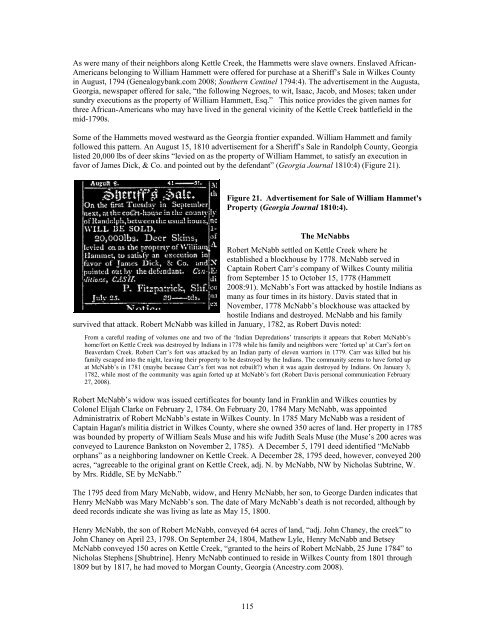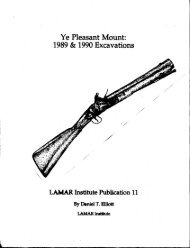Stirring Up a Hornet's Nest: - UGA Laboratory of Archaeology ...
Stirring Up a Hornet's Nest: - UGA Laboratory of Archaeology ...
Stirring Up a Hornet's Nest: - UGA Laboratory of Archaeology ...
You also want an ePaper? Increase the reach of your titles
YUMPU automatically turns print PDFs into web optimized ePapers that Google loves.
As were many <strong>of</strong> their neighbors along Kettle Creek, the Hammetts were slave owners. Enslaved African-<br />
Americans belonging to William Hammett were <strong>of</strong>fered for purchase at a Sheriff’s Sale in Wilkes County<br />
in August, 1794 (Genealogybank.com 2008; Southern Centinel 1794:4). The advertisement in the Augusta,<br />
Georgia, newspaper <strong>of</strong>fered for sale, “the following Negroes, to wit, Isaac, Jacob, and Moses; taken under<br />
sundry executions as the property <strong>of</strong> William Hammett, Esq.” This notice provides the given names for<br />
three African-Americans who may have lived in the general vicinity <strong>of</strong> the Kettle Creek battlefield in the<br />
mid-1790s.<br />
Some <strong>of</strong> the Hammetts moved westward as the Georgia frontier expanded. William Hammett and family<br />
followed this pattern. An August 15, 1810 advertisement for a Sheriff’s Sale in Randolph County, Georgia<br />
listed 20,000 lbs <strong>of</strong> deer skins “levied on as the property <strong>of</strong> William Hammet, to satisfy an execution in<br />
favor <strong>of</strong> James Dick, & Co. and pointed out by the defendant” (Georgia Journal 1810:4) (Figure 21).<br />
Figure 21. Advertisement for Sale <strong>of</strong> William Hammet's<br />
Property (Georgia Journal 1810:4).<br />
The McNabbs<br />
Robert McNabb settled on Kettle Creek where he<br />
established a blockhouse by 1778. McNabb served in<br />
Captain Robert Carr’s company <strong>of</strong> Wilkes County militia<br />
from September 15 to October 15, 1778 (Hammett<br />
2008:91). McNabb’s Fort was attacked by hostile Indians as<br />
many as four times in its history. Davis stated that in<br />
November, 1778 McNabb’s blockhouse was attacked by<br />
hostile Indians and destroyed. McNabb and his family<br />
survived that attack. Robert McNabb was killed in January, 1782, as Robert Davis noted:<br />
From a careful reading <strong>of</strong> volumes one and two <strong>of</strong> the ‘Indian Depredations’ transcripts it appears that Robert McNabb’s<br />
home/fort on Kettle Creek was destroyed by Indians in 1778 while his family and neighbors were ‘forted up’ at Carr’s fort on<br />
Beaverdam Creek. Robert Carr’s fort was attacked by an Indian party <strong>of</strong> eleven warriors in 1779. Carr was killed but his<br />
family escaped into the night, leaving their property to be destroyed by the Indians. The community seems to have forted up<br />
at McNabb’s in 1781 (maybe because Carr’s fort was not rebuilt?) when it was again destroyed by Indians. On January 3,<br />
1782, while most <strong>of</strong> the community was again forted up at McNabb’s fort (Robert Davis personal communication February<br />
27, 2008).<br />
Robert McNabb’s widow was issued certificates for bounty land in Franklin and Wilkes counties by<br />
Colonel Elijah Clarke on February 2, 1784. On February 20, 1784 Mary McNabb, was appointed<br />
Administratrix <strong>of</strong> Robert McNabb’s estate in Wilkes County. In 1785 Mary McNabb was a resident <strong>of</strong><br />
Captain Hagan's militia district in Wilkes County, where she owned 350 acres <strong>of</strong> land. Her property in 1785<br />
was bounded by property <strong>of</strong> William Seals Muse and his wife Judith Seals Muse (the Muse’s 200 acres was<br />
conveyed to Laurence Bankston on November 2, 1785). A December 5, 1791 deed identified “McNabb<br />
orphans” as a neighboring landowner on Kettle Creek. A December 28, 1795 deed, however, conveyed 200<br />
acres, “agreeable to the original grant on Kettle Creek, adj. N. by McNabb, NW by Nicholas Subtrine, W.<br />
by Mrs. Riddle, SE by McNabb.”<br />
The 1795 deed from Mary McNabb, widow, and Henry McNabb, her son, to George Darden indicates that<br />
Henry McNabb was Mary McNabb’s son. The date <strong>of</strong> Mary McNabb’s death is not recorded, although by<br />
deed records indicate she was living as late as May 15, 1800.<br />
Henry McNabb, the son <strong>of</strong> Robert McNabb, conveyed 64 acres <strong>of</strong> land, “adj. John Chaney, the creek” to<br />
John Chaney on April 23, 1798. On September 24, 1804, Mathew Lyle, Henry McNabb and Betsey<br />
McNabb conveyed 150 acres on Kettle Creek, “granted to the heirs <strong>of</strong> Robert McNabb, 25 June 1784” to<br />
Nicholas Stephens [Shubtrine]. Henry McNabb continued to reside in Wilkes County from 1801 through<br />
1809 but by 1817, he had moved to Morgan County, Georgia (Ancestry.com 2008).<br />
115










